Average 3 Car Garage Size Dimensions Guide
Are you planning to build a three-car garage but unsure about the size dimensions? Look no further! This guide will provide you with all the information you need to determine the average size dimensions for a three-car garage, ensuring that it meets your requirements and fits your vehicles perfectly.
Key Takeaways
- The average size dimensions for a three-car garage range from 20’x30′ to 30’x60′.
- Consider factors such as vehicle size, available space, and intended use when determining the ideal size.
- The minimum recommended size for a three-car garage is 24’x36′ to allow for comfortable parking and storage.
- A large three-car garage can be as big as 30’x60′, providing extra space for storage or activities.
- Other considerations include garage square footage, storage needs, door sizes, building codes, future needs, and budget.
How Big is a Three-Car Garage?
When considering the size of a three-car garage, it’s essential to determine the dimensions that will accommodate your needs. The most common dimensions for a three-car garage range from 20’x30′ to 30’x60′. However, the actual size you choose will depend on several factors, including the size of your vehicles, the available space for construction, and the intended use of the garage.
Measuring the size of your vehicles is a crucial step in determining the appropriate garage dimensions. Take note of the length and width of each car to ensure there is enough space for comfortable parking and maneuvering. Plan to leave at least two feet of space in front of and behind the longest vehicle, as well as between each vehicle and the walls of the garage.
Considering the available space is another important factor. Evaluate the area where you plan to build the garage and ensure it can accommodate the desired dimensions. It’s crucial to leave sufficient space around the garage for easy access and movement. Setbacks, local building codes, and other regulations may also impact the available space and required dimensions.
The intended use of the garage will also influence its size. If you plan to use the space for more than just parking cars, such as storage or a workshop, you may need to opt for a larger size. Additionally, if you have larger vehicles like SUVs or trucks, you may require more space to ensure convenient parking and opening of the doors.
Factors to Consider for Determining Garage Dimensions:
- Size of your vehicles
- Available space for construction
- Intended use of the garage
“The size of a three-car garage can vary based on individual needs. It’s important to carefully consider factors such as vehicle size, available space, and garage usage to determine the optimal dimensions for your garage.”
By taking all these factors into account, you can make an informed decision about the size of your three-car garage. Whether you choose a smaller or larger dimension, it’s crucial to ensure it meets your requirements and provides adequate space for parking, storage, and other planned activities.
Minimum Three-Car Garage Size
When it comes to three-car garages, the minimum size you should consider is typically 20’x30′. However, if you want to ensure enough space for comfortably parking three cars and having room for storage, it is recommended to opt for a size no smaller than 24’x36′.
While a smaller three-car garage may be suitable for those with limited land space or smaller vehicles, it’s important to keep in mind that this size may not provide ample storage or maneuvering space. By choosing a minimum size of 24’x36′, you can enhance functionality and create a more versatile space to meet your needs.
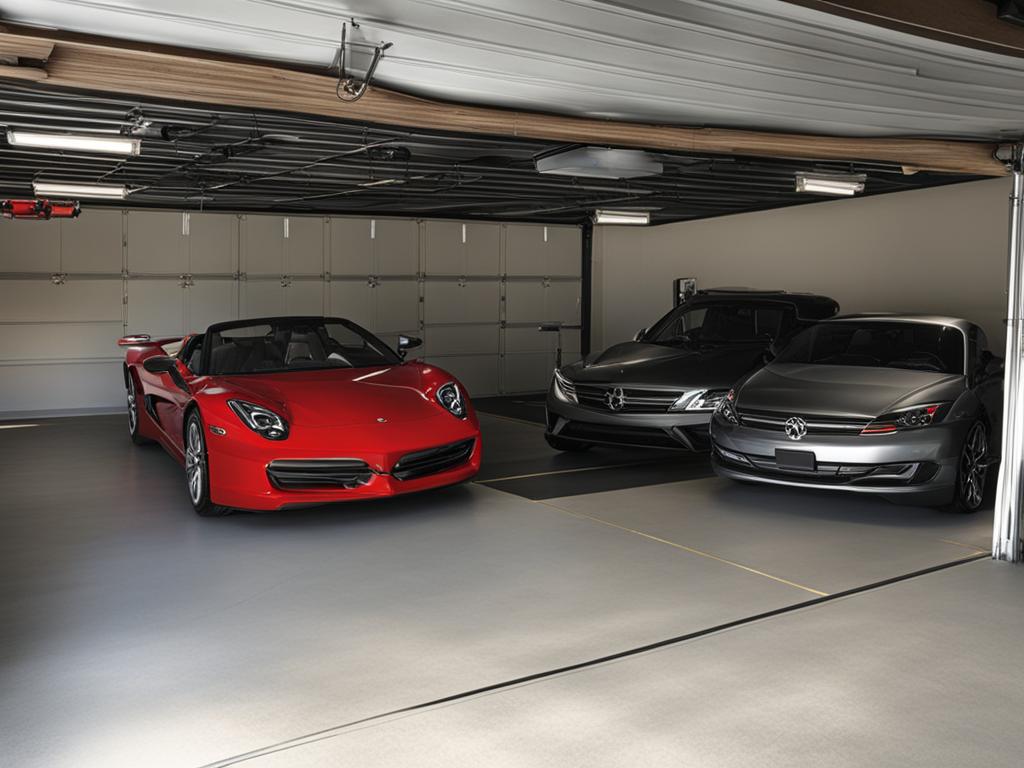
“Having a small three-car garage may seem appealing, but it’s essential to consider future needs and the flexibility required for accessing storage items. Choosing a size that allows for additional storage or workspace will provide more functionality in the long run.” – John Smith, Garage Design Expert
Average Size of a Three-Car Garage
The average size of a three-car garage is about 24’x36′. This size provides enough space to comfortably fit three cars and allows for additional storage or workspace. However, many people opt for larger sizes to ensure easy access and extra storage space.
If you have multiple vehicles or you plan to use your garage for more than just parking, it’s important to consider the size of your three-car garage carefully. Having enough space for maneuvering and storage can make your garage more functional and versatile.
Why Choose the Average Size?
The average size of 24’x36′ is a popular choice for a three-car garage for several reasons:
- Ample parking space: With this size, you can easily fit three cars side by side, providing sufficient space for each vehicle.
- Additional storage: The extra square footage allows for storage shelves, cabinets, and even room for other items such as lawn equipment, bicycles, or sporting gear.
- Workspace: If you enjoy DIY projects or need a dedicated space for hobbies, a 24’x36′ garage size offers enough room for a workbench, tools, and supplies.
By choosing the average size, you can strike a balance between parking space and functionality, creating a versatile space that meets your needs.
Considering a Larger Size
While the average size is suitable for most homeowners, some may prefer a larger three-car garage. Here are a few reasons why:
- Easier access: A larger garage provides more room for opening car doors and maneuvering vehicles, making it easier to park and exit.
- Extra storage: If you have larger items to store, such as a boat or recreational vehicles, a bigger garage allows for their accommodation.
- Future needs: If you anticipate needing more storage space in the future or plan to convert part of the garage into living or office space, a larger size gives you room for expansion.
Keep in mind that a larger garage size may require more space on your property and could be subject to local building codes and regulations. Before deciding on a larger size, it’s essential to consider your specific needs, available space, and any potential restrictions.
Ultimately, the size of your three-car garage should be determined by your individual requirements and preferences. Whether you choose the average size or opt for something larger, it’s important to ensure that your garage meets your parking, storage, and workspace needs for years to come.
Large Three-Car Garage Dimensions
If you have two cars and a larger vehicle, such as a pickup truck, a large three-car garage is the ideal choice. With dimensions of up to 30’x60′, this spacious garage size offers ample room to park your vehicles comfortably.
Not only does a large three-car garage provide enough space for multiple vehicles, but it also allows for additional storage. You can utilize the extra room to store tools, equipment, or recreational items, keeping them organized and easily accessible.
Moreover, a large three-car garage offers the flexibility to create designated areas for various activities. Whether you’re into art, gaming, or any other hobbies, this extra space allows you to set up a dedicated area where you can indulge in your passions without interference.
| Benefits of a Large Three-Car Garage |
|---|
| Ample space for two cars and a larger vehicle |
| Additional storage room for tools and equipment |
| Flexibility to create designated areas for activities |
Investing in a large three-car garage ensures that you have enough room for your vehicles, storage needs, and recreational activities. It provides convenience, organization, and versatility, making it a valuable addition to your property.
Three-Car Garage Square Footage
When planning the dimensions for a three-car garage, understanding the square footage is crucial. The square footage of a three-car garage can vary depending on the dimensions chosen. The minimum square footage for a three-car garage is around 600 square feet (ft²), while the average size ranges from 704 ft² to 900 ft². It’s important to allocate enough space for comfortable parking and additional storage or workspace.
Consider the following table showcasing different dimensions and their corresponding square footage:
| Dimensions | Square Footage |
|---|---|
| 20’x30′ | 600 ft² |
| 24’x36′ | 864 ft² |
| 28’x40′ | 1,120 ft² |
| 30’x60′ | 1,800 ft² |
Determining the appropriate square footage for your three-car garage depends on various factors, including the size of the vehicles, desired storage space, and potential additional areas such as attics or apartment spaces. It’s essential to consider these factors to ensure that the final dimensions meet your specific needs.
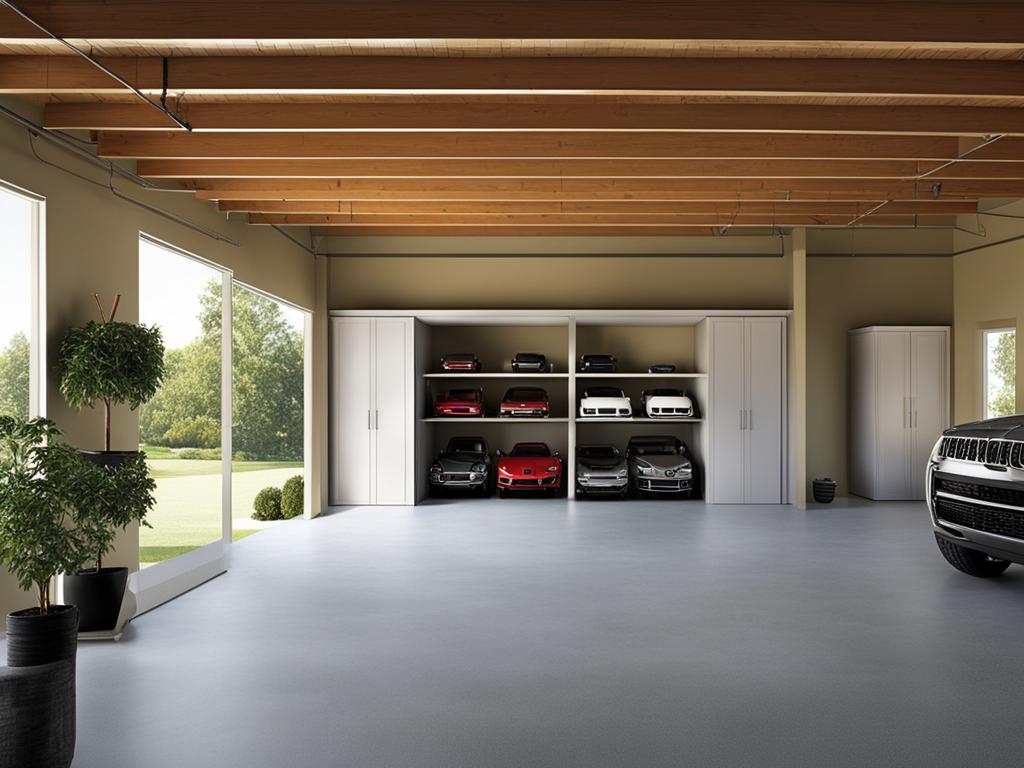
For those seeking both functionality and adequate space, opting for a larger square footage may be ideal. Bear in mind that additional square footage translates to increased construction costs.
How Big Should My Three Car Garage Be?
When determining the size of your three-car garage, there are several factors to consider. By taking these factors into account, you can ensure that your garage dimensions are ideal for your specific needs.
Number of Cars
Firstly, think about the number of cars you need to park in your garage. Do you have three standard-sized cars, or are you planning to park larger vehicles such as SUVs or pickup trucks? Measure the length and width of each vehicle to determine the necessary garage size. Be sure to leave enough space in front of and behind the longest vehicle, as well as between each vehicle and the walls.
Size of Each Car
The size of your cars is another crucial consideration when determining garage dimensions. Measure the length and width of each car to ensure that you have enough space for comfortable parking and maneuvering. It’s recommended to leave at least two feet of space in front of and behind the longest vehicle, as well as between each vehicle and the walls. Adding a few extra feet for convenience and ease of movement is also advisable.
Storage Needs
Think about your storage requirements when determining the size of your three-car garage. Consider how much additional storage space you’ll need for items such as tools, sports equipment, gardening supplies, and seasonal items. Planning for adequate storage space will help keep your garage organized and clutter-free.
Door Sizes
Garage door sizes are an important factor in determining the dimensions of your three-car garage. Standard garage doors are typically 9 feet wide and 7 feet high. However, if you have larger vehicles or prefer a wider entrance, you may opt for larger door sizes. The number of cars and the width of the garage space will influence the door sizes you choose.
Ceiling Height
Consider the ceiling height when determining the size of your three-car garage. A higher ceiling allows for more storage options, such as overhead shelves or racks. Additionally, it provides adequate clearance if you plan to work on vehicles or store tall items like ladders or kayaks.
Local Building Codes
Familiarize yourself with the local building codes and regulations before finalizing the dimensions of your three-car garage. Ensure that your planned garage size complies with the requirements set forth by the building department in your area.
Future Needs and Budget
Anticipate your future needs and budget when determining the size of your three-car garage. Consider if you will require additional space for hobbies, workshop areas, or potential changes in vehicle sizes in the future. Balancing your future needs with your current budget will help you make an informed decision.
| Factors to Consider | Recommended Dimensions |
|---|---|
| Number of Cars | Size of each car + extra space for maneuvering |
| Storage Needs | Additional space for shelving and storage items |
| Door Sizes | Standard or larger door sizes based on car and garage width |
| Ceiling Height | Adequate height for storage options and working space |
| Local Building Codes | Ensure compliance with regulations in your area |
| Future Needs and Budget | Consider potential changes and budget limitations |
By considering these factors, you can determine the ideal dimensions for your three-car garage. Remember to measure accurately and plan for the future to ensure that your garage meets your needs for years to come.
Number of Cars
One of the first steps in determining the size of your three-car garage is to consider the number of cars you need to store. Take inventory of your household vehicles and decide how many cars you want to accommodate in the garage. Whether it’s two cars and a motorcycle or three cars, this will be a crucial factor in calculating the required space.
Once you have determined the number of cars, the next step is to measure the length and width of each vehicle. This will give you an accurate understanding of the space needed to comfortably park each car without any restrictions or tight fits.
Keep in mind that it’s essential to allow enough space in front of and behind the longest vehicle to ensure easy maneuverability. Additionally, leave adequate space between each vehicle and the walls to provide room for opening doors and accessing the vehicles without any hassle.
By accurately assessing the number of cars and their dimensions, you can confidently determine the necessary garage size that will meet your parking needs and ensure convenient access to your vehicles.

| Number of Cars | Length of Each Car | Width of Each Car |
|---|---|---|
| 2 | Up to 16 feet | Up to 6 feet |
| 3 | Up to 16 feet | Up to 6 feet |
| 4 | Up to 16 feet | Up to 6 feet |
Size of Each Car
When determining the dimensions of your three-car garage, it’s essential to consider the size of each car that will be parked in it. Measuring the length and width of each vehicle will help you determine the necessary garage size to accommodate them comfortably and safely.
Start by measuring the length of your longest car from bumper to bumper. This measurement will determine the depth of the garage needed to ensure ample space for parking. Leave at least two feet of space in front of and behind the longest vehicle to allow for easy maneuverability.
For example, if your longest car measures 16 feet in length, the recommended depth of the garage would be at least 20 feet (16 feet + 2 feet in front + 2 feet behind). This additional space ensures that you can open doors and maneuver the car without any obstacles.
Next, measure the width of each car to determine the necessary width of the garage. Leave additional space on either side of each vehicle, typically around two feet, to provide clearance for opening car doors and maneuvering in and out of the vehicles.
For instance, if your widest car measures 6 feet in width, the recommended width of the garage would be at least 10 feet (6 feet + 2 feet on each side). This allows for comfortable access to the car and prevents any potential damage to the vehicle or the garage walls.
It’s worth noting that these measurements provide a baseline for determining the size of your three-car garage. You may choose to add a few extra feet to the dimensions to allow for additional comfort and ease of maneuvering, especially if you have larger vehicles or prefer a more spacious garage.
Example Vehicle Measurements for Garage Size:
| Car | Length (feet) | Width (feet) |
|---|---|---|
| Car A | 16 | 6 |
| Car B | 15 | 5.5 |
| SUV | 18 | 7 |
| Pickup Truck | 20 | 8 |

Using these measurements as a guide, you can calculate the total dimensions of your three-car garage to ensure it accommodates all your vehicles comfortably. Keep in mind that it’s always better to err on the side of caution and opt for a slightly larger garage if you have any concerns about fitting your cars or maneuvering within the space.
Storage Needs
When planning the dimensions of your three-car garage, it’s essential to consider your storage requirements. Determine the amount of garage storage space you will need to accommodate your belongings. This will help you determine how much shelving and storage solutions are necessary to keep your garage organized and efficient.
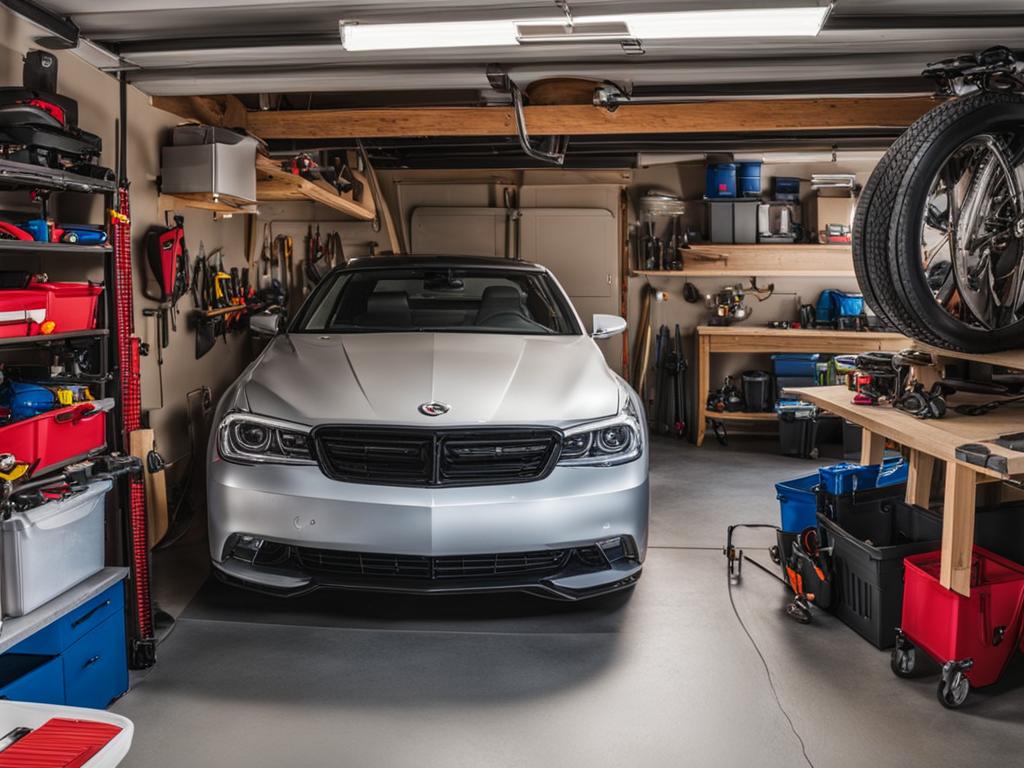
Having adequate garage storage space allows you to store items like tools, outdoor equipment, sports gear, and seasonal items. It’s important to plan for the right amount of storage to prevent overcrowding and ensure easy access to your belongings.
To determine your shelving and storage requirements, consider the following:
- Clutter: Take stock of the items you currently have and estimate how much storage space they require. This will give you a sense of the overall storage capacity you’ll need.
- Flexibility: Decide how flexible you want your storage to be. Would you prefer adjustable shelves or modular storage solutions that can adapt to your changing needs?
- Accessibility: Plan for easy access to frequently used items. Make sure you have designated areas for commonly accessed belongings.
By carefully considering your garage storage needs, you can create a well-organized space that maximizes efficiency and functionality. The right shelving and storage solutions will help you keep your garage clutter-free and ensure that everything has its proper place.
| Storage Requirements | Considerations |
|---|---|
| Shelving | Adjustable shelves for flexibility |
| Modular Storage Solutions | Adaptable systems that can be customized |
| Accessibility | Easy access to frequently used items |
Door Sizes
When determining the dimensions of your three-car garage, it’s essential to consider the size of your garage doors. The dimensions of your doors will depend on the number of cars you plan to park in the garage and the width of the garage space.
Typical garage doors are 9 feet wide and 7 feet tall. These standard-sized doors are suitable for most three-car garages and provide ample space for vehicles to enter and exit. However, if you have larger vehicles or prefer extra space for maneuvering, you can opt for larger door sizes.
Remember to take into account the overall width of your garage space when choosing door dimensions. Ensure that the doors can be comfortably accommodated without any obstructions.
If your three-car garage has additional width, you may consider installing oversized or double-sized doors. Oversized doors, typically measuring 10 or 12 feet wide, can accommodate larger vehicles such as SUVs or trucks. Double-sized doors, often referred to as two-car garage doors, can provide a wider entrance for easier parking of multiple vehicles.
Before finalizing the door sizes, it’s advisable to consult with a professional garage door installer to ensure proper fit and functionality. They can help you assess the ideal door sizes based on your specific garage dimensions and vehicle requirements.
To visualize the door sizes and their potential impact on the overall aesthetics of your three-car garage, here’s an illustrative example:

|
“Choosing the right door sizes for your three-car garage is crucial for convenience and functionality. Oversized doors or double-sized doors can accommodate larger vehicles and make parking a breeze. Consider consulting an experienced installer to ensure the best fit for your specific garage dimensions.” – Expert Garage Doors
Building Codes and Regulations
When planning to build a three-car garage, it is crucial to familiarize yourself with the local building codes and regulations that pertain to these structures. Adhering to these codes not only ensures compliance but also helps to avoid potential penalty fees or other consequences.
One key regulation to consider is the International Building Code (IBC), which provides guidelines for construction, including garage buildings. While the IBC does not specifically outline requirements for three-car garages, it sets the standards for construction practices and safety measures that must be followed.
To ensure compliance, it is important to research and understand the specific building codes and regulations that apply to your area. These requirements may vary depending on factors such as location, zoning, and local ordinances. Consulting with your local building department or obtaining guidance from a professional architect or contractor can provide valuable insights into the necessary permits and procedures.
Additionally, consider the following aspects when designing your three-car garage:
- Size limitations: Some building codes may restrict the maximum size of the garage based on factors such as property size, setback requirements, and neighborhood regulations.
- Structural requirements: Building codes typically specify minimum standards for structural components, including foundations, walls, roofs, and doors. It is essential to ensure that your garage complies with these requirements to guarantee the safety and integrity of the structure.
- Fire safety: Building codes often include provisions for fire resistance, such as fire-rated walls, proper ventilation systems, and the installation of fire extinguishers. Complying with these regulations can help prevent the spread of fire and protect your property.
- Electrical and plumbing: If you plan to include electrical wiring or plumbing fixtures in your garage, it is crucial to meet the electrical and plumbing code requirements. This includes ensuring proper installation, adequate wiring capacity, and compliance with safety standards.
- Accessibility and egress: Building codes often specify requirements for accessibility and egress, including minimum ceiling height, door widths, and safety features such as emergency exits. These provisions aim to ensure that the garage can be safely accessed and evacuated if needed.
By familiarizing yourself with the relevant building codes and regulations and incorporating them into your garage design, you can ensure a safe, compliant, and functional three-car garage that meets your needs and adds value to your property.
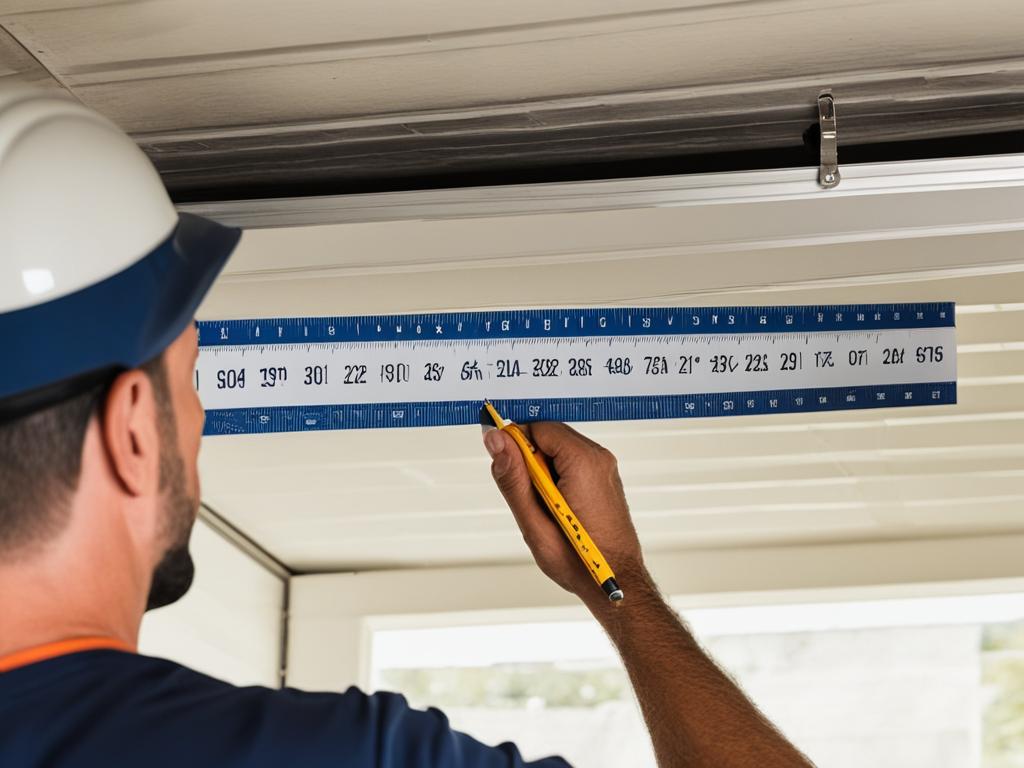
Other Considerations for Three-Car Garage Size
When determining the size of your three-car garage, there are several additional factors to consider apart from the number of cars you need to park. These factors include ceiling height, future needs for the garage space, and budget.
Ceiling Height:
Take into account the height of your vehicles and any additional requirements you may have. Ensure that the garage has enough clearance from the ceiling to accommodate taller vehicles or storage racks. A higher ceiling can also make the space more versatile for future needs such as installing a car lift or using the space for other activities.
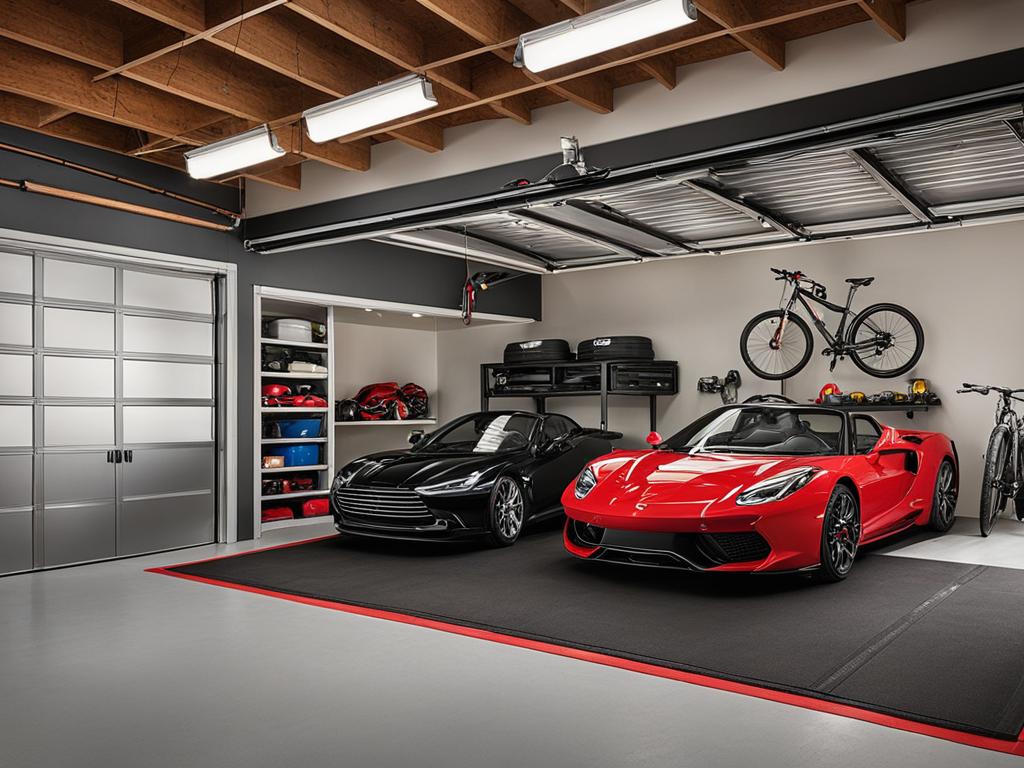
Future Needs:
Consider your future needs for the garage space. If you plan on using the garage for more than just vehicle storage, such as a workshop, exercise area, or hobby space, it’s important to allow for additional room. Factor in the space required for equipment, workbenches, storage cabinets, or any other activities you plan to undertake in the garage.
“It’s always a good idea to plan for future uses of your garage so that you won’t regret not having enough space down the road.” – John Smith, Garage Design Expert
Budget:
Consider your budget when determining the size of your three-car garage. Larger garage sizes will typically cost more in terms of materials, construction, and ongoing maintenance. It’s important to find a balance between the garage size you need and what you can comfortably afford.
By taking into account these additional factors of ceiling height, future needs, and budget, you can ensure that the size of your three-car garage meets all your requirements and provides a functional and versatile space for your vehicles and other activities.
Minimum Size for a 3 Car Garage
The smallest size for a three-car garage is generally 20 feet wide and 30 feet deep. This size is suitable for limited land space or housing smaller cars, but it may not provide ample storage or maneuvering space. Consider opting for a size no smaller than 24×36 feet for better functionality.
If you have limited land space or smaller vehicles, a 20×30 feet three-car garage may be sufficient. However, it is important to note that this size may not allow for additional storage or the comfortable maneuvering of vehicles.
For a more functional three-car garage, it is recommended to choose dimensions no smaller than 24×36 feet. This size provides enough room to park three cars comfortably while allowing for additional storage space and easier movement within the garage.
When determining the size of your three-car garage, consider factors such as the size of your vehicles, the available land space, and your storage needs. A larger garage size can provide more versatility and convenience, but it is crucial to find the right balance that suits your specific requirements.
Whether you opt for the minimum size or a slightly larger dimension, ensure that your three-car garage meets your needs while complying with local building codes and regulations. By carefully considering these factors, you can create a garage that maximizes functionality and enhances your overall experience.
Optimal Three-Car Garage Sizes
To help you envision the different dimensions for a three-car garage, here are some popular options to consider:
| Garage Dimensions | Benefits |
|---|---|
| 20×30 feet | – Suitable for limited land space – Ideal for storing smaller cars – May lack storage and maneuvering space |
| 24×36 feet | – Provides ample space for three cars – Allows for additional storage – Offers better maneuvering space |
| 30×40 feet | – Offers generous space for three cars and storage – Provides extra room for larger vehicles |
Remember, these dimensions are just examples, and the optimal size for your three-car garage will depend on your specific needs and preferences.

Legal Requirements for Three Car Garages
When planning the size of a three-car garage, it is crucial to understand and comply with the applicable building codes and regulations. While there are no specific laws for three-car garages in the United States, these structures generally fall under the purview of the International Building Codes (IBC). Familiarizing yourself with these codes and any additional local regulations is essential to avoid penalties and ensure your garage meets the required standards.
Building codes and regulations for three-car garages focus on various aspects, including construction materials, structural integrity, safety features, and dimensions. Local building authorities set these regulations to ensure garages are built to minimum standards that promote safety, durability, and functionality.
One key consideration in building a three-car garage is the required size or dimensions of the structure. Building codes typically provide guidelines and minimum requirements for garage size to ensure adequate space for parking vehicles and maneuvering within the garage. Garage size requirements can vary depending on the area and specific regulations. Therefore, it is essential to consult the local building department or relevant authorities to determine the specific requirements for your location.
To give you an idea of the dimensions commonly recommended for a three-car garage, the table below showcases some typical sizes:
| Garage Size | Dimensions (feet) |
|---|---|
| Minimum Size | 20’x30′ |
| Recommended Size | 24’x36′ |
| Large Size | 30’x60′ |
These dimensions provide a general guide, but it is important to note that they may vary based on local building codes and regulations. Always consult with local authorities to ensure compliance with specific requirements.
Considering the legal regulations and building codes for three-car garages is not only a matter of compliance but also a way to ensure the durability and value of your garage. By adhering to these standards, you can create a safe and functional space that meets your needs and protects your investment.
Conclusion
When determining the size of a three-car garage, it is essential to consider several factors. The number and size of vehicles play a significant role in determining the dimensions of the garage, ensuring that there is enough space to comfortably park and maneuver each vehicle. Additionally, take into account your storage needs, as a three-car garage should provide ample space for storing items such as tools, equipment, and other belongings.
It’s also crucial to think about future plans for the garage and your budget. Consider whether you may need additional space for activities or if your storage needs may increase in the future. Planning ahead will help ensure that the garage size meets your long-term needs and avoids the hassle of potential renovations or expansions down the line.
Ultimately, designing a three-car garage that offers sufficient space and functionality requires careful consideration of all these elements. Taking the time to plan and determine the ideal dimensions will result in a garage that not only accommodates your vehicles but also provides the storage and flexibility you require. By following these guidelines and factoring in your specific needs, you can create a three-car garage that perfectly suits your lifestyle.
FAQ
How big is a three-car garage?
The dimensions for a three-car garage can range from 20’x30′ to 30’x60′, depending on factors such as the size of your vehicles and available space.
What is the minimum size for a three-car garage?
The minimum recommended size for a three-car garage is typically 24’x36′ to ensure enough space for three cars and storage.
What is the average size of a three-car garage?
The average size of a three-car garage is approximately 24’x36′, providing enough room for three cars and additional storage or workspace.
How large can a three-car garage be?
A large three-car garage can be as big as 30’x60′, accommodating two cars and a larger vehicle like a pickup truck, with ample space for storage or designated areas for activities.
What is the square footage of a three-car garage?
The square footage of a three-car garage can vary, but the minimum size is around 600 sq. ft. and the average size is approximately 704 sq. ft. It’s important to consider additional space requirements such as attics or apartment spaces.
How do I determine the ideal size for my three-car garage?
Consider factors such as the number and size of cars, storage space needs, door sizes, ceiling height, building codes, future needs, and budget to determine the optimal dimensions for your three-car garage.
How do I determine the number of cars that can fit in a three-car garage?
Measure the length and width of each car to determine the necessary garage size. Leave space in front of and behind the longest vehicle, as well as between each vehicle and the walls.
What should I consider when determining the size of each car for my three-car garage?
Consider the length and width of each car, leaving at least two feet of space in front of and behind the longest vehicle, as well as between each vehicle and the walls. Adding a few extra feet for comfort and maneuvering is recommended.
How should I plan for storage needs in my three-car garage?
Consider the amount of shelving required and the flexibility needed for accessing storage items. Plan for adequate space to accommodate storage needs without overcrowding the garage.
What are the door size considerations for a three-car garage?
Typical garage doors are 9×7 feet each, but you can opt for larger doors if desired. The door sizes will depend on the number of cars and the width of the garage space.
What building codes and regulations should I be aware of for a three-car garage?
Familiarize yourself with local building codes and regulations, including International Building Codes and any specific requirements for your area. Failure to comply with these codes may result in penalties or other consequences.
What other factors should I consider when determining the size of my three-car garage?
Consider factors such as ceiling height, future needs for the garage space, and your budget. Determine if you require extra space for activities or anticipate additional storage needs in the future.
What is the minimum size for a three-car garage if I have limited land space?
The smallest size for a three-car garage is generally 20 feet wide and 30 feet deep. However, opting for a size no smaller than 24’x36′ is recommended for better functionality and storage space.
What are the legal requirements for three-car garages?
While there are no specific laws for three-car garages in the US, these structures typically fall under the International Building Codes. It’s essential to familiarize yourself with local regulations to ensure compliance and avoid penalties.
How should I determine the size of my three-car garage?
The size of a three-car garage should be determined based on factors such as the number and size of vehicles, storage needs, future plans, and budget. Consider all these elements to ensure that the garage adequately accommodates your needs.




